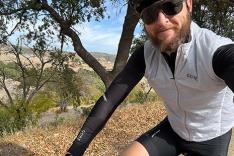
The good news, as most of you already know, is the number of cyclists is increasing every year. The bad news? We are starting to crash into each other.
For the first 22 years of my legal career (1986-2008) I received a total of two calls regarding bike v. bike incidents. In the past 12 months, however, I have received more than a dozen such calls with injuries ranging from bumps and bruises to concussion and serious fractures requiring multiple surgeries.
This is similar to what happened in the early days of the automobile. At first, most car crashes involved livestock and inanimate objects. It wasn't until the car increased in popularity that drivers started hitting each other.
In many states, the "Rules of the Road" pertaining to motor vehicle drivers also apply to bicyclists.
Of the 12-plus bike vs. bike incident calls I have received lately, roughly half occurred on multiuse trails and half on the roadway. While the "Rules of the Road" generally only apply on the roadway, the same principles also apply on multi-use trails. From a liability standpoint, even though you are riding on a trail you will be held to the same standard of care that applies to motor vehicle operators. That is, what would a reasonable bicyclist have done in the same situation?
Some of the more common problems include: Failing to signal while turning; following too closely; stopping suddenly; riding on the wrong side of the path; and turning left or right without yielding the right-of-way to other cyclists.
While riding in a pace line is fun and efficient, we would never think it was prudent to drive our car at 20-25 mph while following only six to 12 inches behind the bumper of the car in front of us. We need to ride our bikes like we drive our cars. That is, we need to ride predictably and use common sense.
Communicate your intentions both verbally and with hand signals. Tell other riders in a loud and clear voice that you are turning, stopping, standing, slowing, etc. Do not ride faster than either your skills or the road/path conditions warrant.
What should you do if you find yourself involved in a bike vs. bike crash?
- Remain calm and non-confrontational.
- Move safely off the road or path.
- Seek appropriate medical treatment.
- Exchange contact information.
- Thoroughly inspect your bike for damage before riding it again.
If there is only minor property damage and no one is clearly at fault, you may want to simply go your separate ways and chalk it up to experience. If there is serious property damage and/or injuries, the at-fault cyclist's homeowners or renters insurance, if any, should provide coverage. As you might expect, your auto insurance will not provide any coverage in a bike v. bike crash.
Be smart. Follow the "Rules of the Road" and ride predictably!
John Duggan is an avid cyclist and Seattle attorney who represents injured cyclists. He can be reached at 206-343-1888 or john@dugganbikelaw.com.








Discuss This Article